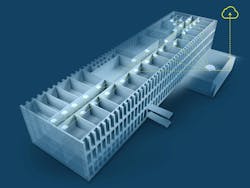Self-Governing Wireless Networks Can Empower Smart Buildings
This article appeared in Microwaves & RF and has been published here with permission.
This article is part of the TechXchange: Wireless IoT Technologies.
What you’ll learn:
- The implementation of smart buildings and facilities and the migration to more intelligent systems.
- Challenges and barriers to adoption must be overcome due to infrastructure requirements and the related supporting technologies.
- How advanced wireless solutions like NeoMesh offer reliability, scalability, and low-power operation to enable facility networks to be easily created.
The move to smart buildings and facilities will significantly impact the marketplace. According to FortuneBusinessInsights.com, the smart-building market is projected to grow from $80.62 billion in 2022 to $328.62 billion by 2029, at a CAGR of 22.2% in the forecast period from 2022-2029 (Fig. 1).
Making buildings and facilities smarter isn’t just a fad—it delivers real-world operational and financial benefits. Intelligent sensors provide data that gives useful information, for example, to achieve reduced heating costs, optimize ventilation and HVAC, manage lighting, and improve the overall energy efficiency of the building. A smarter building is more sustainable, with reduced maintenance costs. It also optimizes use of its spaces, making occupants of the building more comfortable, which often leads to better productivity.
The cost barrier to adoption of such systems is real but often overblown. Still, facilities managers are sometimes hesitant to introduce intelligent systems in older buildings because of the cost of cabling to connect to the sensors and subsystems.
However, wireless IoT and cloud technology has reached the point where you can manage a smart building without cables. Data can easily be sent wirelessly to the cloud or building management systems, bypassing the need to re-cable the building. The challenge is nonetheless complex—it’s not possible to simply visit a hardware store and buy a do-it-yourself hardware kit. Therefore, facilities managers will need the advice of a consultant to select the most appropriate solution for their sites.
A good example of such a wireless smart-building implementation can be found in the upgrades made to a Copenhagen office building. Nrlyze, a company that focuses on optimizing energy systems to reduce energy waste in the real-estate sector, implemented the self-governing and flexible NeoMesh network technology from NeoCortec.
The wireless network enabled the company to quickly roll out a large and capable sensor infrastructure in a cost-effective manner. It sets itself up and automatically establishes connectivity between the sensors, easing integration efforts and reducing the need for complex cable installations (Fig. 2).
Wireless Solutions Ease “Final Meter” Pressure
Creating a smart building with wireless mesh technology is the most cost-effective way to implement an intelligent facility infrastructure, especially when it comes to pre-existing buildings. In such older structures, getting from the wiring behind the wainscotting to the intelligent systems inside the rooms presents a significant “final meter” problem to connect the cables behind the walls to the intelligent sensors and devices.
Often, these buildings don’t even have wires (except mains power) at all. Therefore, the challenge is both to power devices and get data in/out of the devices.
Wireless solutions come in different types, based on how the network is managed. This will impact the final implementation’s ability to operate and respond to challenges.
A flat and distributed node-based mesh topology has significant advantages when compared to star-type hierarchical networks with a central processing hub. Many mesh technologies are still star-based in nature. However, truly decentralized mesh wireless solutions, such as NeoMesh, offer robustness, self-healing, and the ability to get around obstacles in a way that’s not possible with a star-based network.
If a node in a star-based solution has a poor or even a broken link to the gateway, for example, there is no redundant link which can be leveraged. In a decentralized structure where all nodes can act as routers of data on behalf of each other, there is no single point of failure, and if an individual node goes down, the system re-routes through an alternative pathway.
Of course, there still needs to be a gateway from the mesh to the building’s systems. An advantage of a mesh solution like the flexible NeoMesh network technology from NeoCortec is that you only need one central gateway to collect all of the sensor data and transmit it to the cloud. There’s no need for repeaters or additional gateways to connect different parts of the network. Embedding the NeoMesh protocol in Nrlyze’s platform addressed the need for network size, scalability, installation flexibility, and optimal performance of all nodes in the network.
NeoMesh Network Technology
The advantage of NeoMesh network technology over legacy mesh networks like Zigbee, Thread, Wi-Fi, and Bluetooth is that it addresses issues like power consumption, network size, network management, and high reliability in transporting data. For example, it synchronizes the nodes to each other timing-wise, for ultra-low power consumption in all parts of the network. Decentralized network management significantly reduces vulnerability by preventing any single point of failure from impacting the network.
NeoCortec developed its second-generation mesh technology to directly address the world of wireless, low-power sensor networks for smart-building and other IoT applications. NeoMesh leverages self-governing nodes to form networks autonomously, allowing for extreme scalability, node mobility, and optimum performance. Each node in the network is asleep most of the time and only wakes up when necessary.
Consequently, all nodes are equally power-efficient, while maintaining full routing capabilities. The result is that the entire network can be low power and thus run on batteries for many years.
Here, it’s also vital that other mesh networks are able to claim that nodes consume very little power and, therefore, run off batteries. However, they also require hubs or repeaters which are much more power-hungry. As previously mentioned, with NeoMesh, each node is equal, so there’s no need for hubs or repeaters, and the entire system can be battery powered.
NeoMesh network technology decentralizes network management, with the functional relationships between the nodes created and maintained locally, making it relatively simple to deploy from a few to a few thousand nodes in a network. The NeoMesh routing protocol creates a route for the data packages to travel through the network. It manages any data-transmission issues, with real-time routing of data over long distances through multiple hops, while still using very little energy.
Network Robustness and Security
NeoMesh also meets the robustness and security standards demanded by building and facilities managers. The high level of security is ensured through ACK/NACK, AES128 encryption, CRC32 handshake, and Challenge/Response authentication between source and destination. In addition, reliable radio communication is ensured through frequency hopping for more robust performance.
The network is also easy to deploy because it’s self-forming—the system grows as you add new nodes, which automatically connect to the network. All you need are the communication nodes themselves (with batteries), antennas, and, of course, the appropriate sensors.
The second-generation mesh technology behind NeoMesh makes it a versatile and robust wireless network for connecting nodes, with true low-power connectivity, flexibility, and scalability, as well as no recurring licensing fees. Hundreds, even thousands, of devices can be included on the same network, so an entire building of any size can be covered. Installation creates no disruption—devices are stuck to a wall in minutes. Thus, employees can carry on working while the network is set up.
Incremental Network Setup
Another advantage to NeoMesh is that upgrading a building to a smart facility can be done incrementally, adding one aspect of functionality at a time rather than all of it at once. This means that there’s a lower investment threshold for any given building owner, since they only have to install and pay for functionality that brings value, as required. The scalable nature of a NeoMesh network (up to 65k nodes) also means no additional gateways or repeaters are needed to cover very large areas, as long as there are enough nodes to provide sufficient density in the network.
In the case of the three-floor Copenhagen office building example, it only took a few hours to install all 93 temperature and humidity sensors, which automatically connected to each other due to the self-governing NeoMesh network protocol. Using battery-powered sensors meant no additional power cables were required, and after installation, the sensors started to transmit data to the cloud without any need to configure the network.
Conclusion
To improve operation and reduce inefficiencies, advanced analytics must be provided for building owners and facility managers, enabling them to fine-tune their building control systems. Exact and continuous measurements are essential in this optimization effort, and the flexible and scalable NeoMesh network technology can facilitate that smart-building functionality in an efficient, low-power, and cost-effective manner.
Read more articles in the TechXchange: Wireless IoT Technologies.


